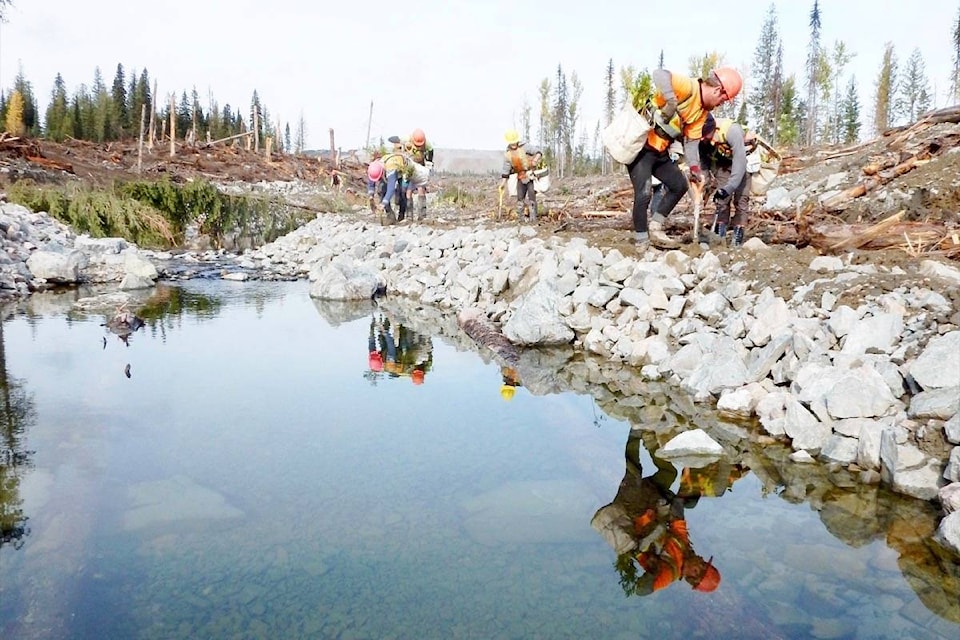Four years and a bit after the Mount Polley Mine disaster a meeting held in Williams Lake to update the public on remediation work attracted less than a dozen people.
Held Friday, Dec. 14 at the Royal Canadian Legion’s lower level, the two-hour meeting covered remediation, monitoring and a rainbow trout project.
Lee Nikl of Golder Associates gave an overview of remediation activities carried out by the company since the Aug. 4, 2014 tailings impoundment breach.
Work has included habitat remediation, constructing habitat, removing tailings all through Hazeltine Creek, and rock armoring.
As for Quesnel Lake, Nikl showed a slide indicating in one section there is a10-metre in height deposit of tailings and in other areas it measure one metre in height.
“When we look at what did we have, and what did we want, we had certain ecological functioning happening with organisms down in the lake bed that we want to come back. That’s our remediation objective,” he said.
Data from 2017 is being analyzed in the lab, however, Nikl said some samples taken from the lake bed from 2014 showed no organisms and some with a few.
In 2015 there were samples showing more bugs and by 2016 the number of bugs in the mud was increasing.
“We think it will continue to do that for a number of reasons from other studies we’ve seen,” Nikl said.
Responding to the suggestion the tailings be dredged from Quesnel Lake, Nikl said it would be problematic.
The deepest the equipment can go is -70 metres and to dredge the lake would require equipment that can go to -100 metres.
For the type of equipment needed to remove the total volume which is 32 million cubic metres and the storage facility required, would take five to 10 years of studies for designing, permitting and procurement.
“The production rate would be about 6,000 cubic metres of solids per day and if we are running 24/7 for six months of the year — you can’t work when there is ice — would work out to about 30 years of dredging on the lake. And the dredging would cause more turbidity on the lake and the people living on the lake really don’t like that. They like the clear water. It would be disruptive for people and for the organisms that live there.”
Read more: Disciplinary hearings announced regarding Mount Polley Mine breach
Valerie Holweck, environmental co-ordinator at the mine, outlined monitoring at the site that is part of their Comprehensive Environmental Monitoring Plan (CEMP), which was updated on Nov. 9, 2018.
Under the CEMP they are required to monitor contact water — any water that has gone on top or through a waste rock pile. Seeps are collected in ditches and conveyed to sumps and then sampled for water chemistry.
They also monitor groundwater, hydrology, vegetation, soil, surface water, discharge water, lakes, phytoplankton and zooplankton, fish, algae, bugs and wildlife.
Discharge water comes out of the water treatment plant and is tested for chemistry and biology for the CEMP and for Environment Canada.
“Surface water is a major category of what we monitor, and refers to any receiving environment such as Hazeltine and Edney Creeks around the mine site, also extends to Polley, Bootjack and Quesnel Lake,” Holweck said. “They are monitored for chemistry.”
Lake sampling includes Polley, Bootjack and Quesnel Lakes.
“In Quesnel Lake we have a sampling site that is 100 metres from the initial dissolution zone and treated effluent diffuser ports,” Holweck said. “We also have reference areas in Quesnel Lake upstream and downstream of those and in the west arm and down further toward the junction.”
Likely resident Doug Watt raised concerns about the water treatment plant only removes solids and doesn’t remove chemicals such as copper or nutrients such as phosphate or nitrates.
“Earlier in the year you had a problem with copper levels and had to divert it to the tailings storage facility,” Watt said. “Can you explain what happens to treat that water after it goes there.”
Nikl said the treatment plant’s design takes into account the form in which the metals are in.
“Copper is associated with the matrix of the solid particles. It is in the solid form so the efficient form to remove the copper is to remove the solids which is why the plant is optimized for that.”
Lyn Anglin, vice president of corporate affairs for Imperial Metals, said the water from the tailings pond is also recycled back to the mill in a closed loop.
Cariboo Chilcotin Conservation Society president Bill Lloyd said he would like to have a reference point to be able to compare water quality.
“I think it would be helpful for the layman if you had a jug of water from Hazeltine Creek on the table, and a jug of water from the discharge pipe and a jug of water from Quesnel Lake.” Lloyd said.
“If you include a chemical analysis of all those, it would answer a lot of questions for the average person on what is there now and what is going into the lake.”
This is the first article in a series generated by the in formation shared at the public meeting held Dec. 14 in Williams Lake
Read more: Mount Polley and USW reach agreement
news@wltribune.com
Like us on Facebook and follow us on Twitter
